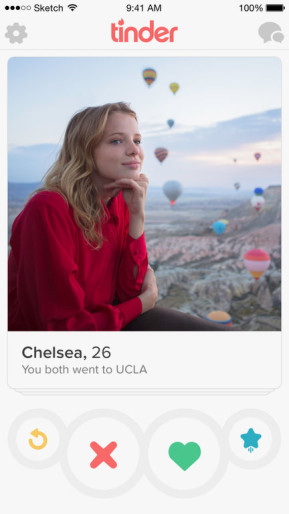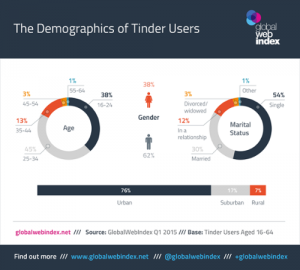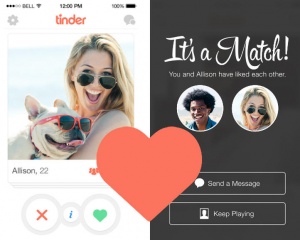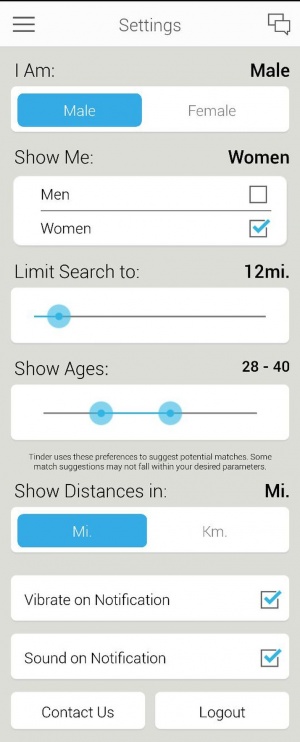Tinder
|
Tinder is a mobile dating application that allows users to meet others based on a profile composed of one or more photos, taken from Facebook, and a short biography. Users swipe right if they like the person or left if they do not. A match is made when two users both swipe right on each other. When Tinder was launched, it was especially popular on college campuses, where students use the dating service for many possible reasons: meeting new friends, hooking-up, and finding significant others. Tinder has since become popular in markets beyond college students and has inspired a host of other Tinder-like apps. It has largely been known as a hook-up application, but due to Tinder’s simplicity, users also use it casually to meet new people and make new friends, or potentially find their future partner.
Contents
History
Sean Rad, Justin Mateen, and Jonathan Badeen are the founders of Tinder. Sean and Justin both grew up in Los Angeles and knew of each other since they both went to private high school together. However, they did not become close until freshman year in a math class at USC in Fall 2004.[1]
In 2009, Sean launched Adly, a celebrity social advertising platform where users create campaigns.[2] He shortly sold the company in Fall 2011 due to a decrease of interest in dealing with celebrities and advertisers. Sean then joined an incubator called Hatch Labs, funded by IAC and Xtreme Labs (Hatch Labs was later shut down in 2013).[3] There Sean met Jonathan Badeen, and the three of them came up with the idea of Tinder. This dating application mimics another application called Hot or Not, a rating site where users rate the attractiveness of the person in the photograph on a scale of 1-10.[4]
Tinder was seeded on a few college campuses and later spread to more campuses due to the increasing attention it received among college students. The dating application started off with a user base primarily made up of 18-24 years old and has now expanded widely to other age groups, where 45% of users are between 25 – 34 years old.[5]
Tinder was released on September 12, 2012. As of March 2015, there are 196 countries who use Tinder, roughly 50 million users, and 26 million matches made daily.[6]
How Tinder Works
Tinder is a free dating service application available for download on Android and iOS.
In order to use Tinder, the application first asks for the user’s permission to access the user's Facebook profile to retrieve simple information such as the user’s name, age, photos, and interests. The application also uses Facebook to access the user’s mutual friends and matches the user with friends of mutual friends. This information is then used to create the user’s Tinder profile.
The user can then adjust the settings for their preference of gender, the user's age group, and how far the user is willing to travel to meet other Tinder users.
During the main phase of the app, the user browses through pictures of people who have a short biography tagged with them. If the user likes the person that they see on the screen, they can swipe right or tap the green heart icon. If not, they can swipe left or tap the red cross icon. If both users swipe right on each others' profiles, the two users are notified that a match has been made and they can begin messaging each other.[7]
Controversies
Due to the widespread usage of Tinder, the dating service application has received mixed reviews.
On August 2015, Vanity Fair released an article called “Tinder and the Dawn of the ‘Dating Apocalypse’”, which blames Tinder and other dating applications for the upbringing of the hook-up culture. The article argues that due to the large selection of men and women on the site, people are forgetting the meaning of real relationships and instead are valuing each other as sexual objects. Women are getting their hearts broken while men are enjoying the freedom of ‘no strings attached’. One guy Vanity Fair interviewed said, “you could talk to two or three girls at a bar and pick the best one, or you can swipe a couple hundred people a day – the sample size is much larger…two or three Tinder dates a week can rack up 100 girls you’ve slept within a year”.[8]
Tinder fired back on Twitter stating that they are unfairly portrayed, arguing that those looking to hook-up make up a small population of Tinder and are not representative of the whole user base. Tinder further states that “they create experiences and connections that otherwise never would have been made” and that their site brings more users together for serious relationships and marriages.[9]
Mel Robbins, a CNN commentator, believes that online dating applications such as Tinder have not fundamentally changed human behavior. She states that casual sex has always been prevalent in our culture, and “these apps just make it available to the masses”.[10] Men and women both have different views on relationships so communication should be established from the start. Men are found to use Tinder for easy hook-ups due to the wide accessibility to women. Women who expect that casual hook-ups will turn into intimate relationships complain that it is hard to find a great guy who will commit easily on sites like Tinder.
Additionally, Tinder has received some negative feedback due to its lack of inclusivity for different genders and sexual orientations. When setting up a Tinder profile, one must select their gender as male or female, and must select either looking for women, or looking for men. Yet, many women report that even if they are "interested in women," their feed will still include many male profiles. Others report that they are often notified that there are no more users in their area. Tinder is designed to focus on the needs of straight individuals, and as a result, is often critiqued for perpetuating heteronormative culture. [11]
Scam Bots
With all social media based applications now and days it is only a matter of time before fake profiles/accounts start to populate the platform. It has already happened to Tinder and scammers have created thousands of fake profiles. The "Scam Bots" goal is to con users out of money or bait them into downloading malware. The Scam Bots typically respond within microseconds of matching with them and keep their responses very generic. They do not delve into deep conversation they hope that the fake photos on the profile are appealing enough to convince users to overlook the validity of the profile.
Ethical Implications
Integrity
Since Tinder users are rated based on their personal appearance, pictures that they put up on their dating profile may not be exact representations of who they are in real life. DailyMail.com posted an article of Tinder users’ pictures to show the high contrast of people’s appearances online vs. offline.[12] In addition, hackers and malicious user with cyber-stalking intentions can create a fake Facebook profile with pictures of someone else and pose as them on Tinder. With the lack of integrity, users who meet up with others on Tinder could end up in potential danger.
Privacy
With GPS-enabled tracking location, there is a high possibility for dating applications like Tinder to have privacy breaches. In July 2013, Quartz found that Tinder revealed users’ exact longitude and latitude and Facebook ID. Tinder did not fix the issue until 2 weeks later[13] and users were not even notified of the breach. In November 2013, Quartz found another privacy hole in Tinder where the API design is flawed so that a user can fool Tinder into thinking a match has been created when it has not been, allowing the user to find another user’s email address.[14]
Furthermore, mobile applications collect very sensitive information compared to web-based dating services. Security measures on apps such as Tinder are therefore more robust. Even when Tinder does not show the actual location of the user but rather the distance of other users, malicious users can find the packets to recover users' actual locations.[15] Internet researchers stated that Tinder users give such detailed information, including “mileage to 15 decimal places that would allow any hacker with rudimentary skills to pinpoint a user’s location to within 100 feet”.[16] The privacy holes that plague Tinder consequently bring up the moral ethics of mobile dating applications. As much as Tinder promises to protect the information of its users, the use of Facebook tokens creates a big privacy risk to users.[17]
References
- ↑ Inside Tinder: Meet the Guys Who Turned Dating Into An Addiction
- ↑ Adly - The Celebrity Social Advertising Platform
- ↑ Hatch Labs
- ↑ Hot or Not
- ↑ Wired - 42 Percent of Tinder Users Aren't Even Single
- ↑ DMR - By the Numbers: 37 Impressive Tinder Statistics
- ↑ What is Tinder: How does Tinder work?
- ↑ Tinder and the Dawn of the "Dating Apocalypse"
- ↑ The Guardian 'The Tinder Generation is real'
- ↑ CNN 'Has Tinder Replaced Dating with Hookup Culture?'
- ↑ Which Dating App is the Most Queer-Friendly?, Mosthof, Mariella, 4 March 2015 http://www.autostraddle.com/everybody-fucking-hates-tinder-and-we-are-all-going-to-die-alone-224856/
- ↑ Tinder vs. Reality
- ↑ Quartz 'Tinder's Privacy Breach Lasted Much Longer than the Company Claimed'
- ↑ Quartz 'Dating App Tinder is Still Exposing Personal Information'
- ↑ Analysis of Privacy and Security Exposure in Mobile Dating Applications
- ↑ New Tinder Security Flaw Exposed Users' Exact Locations for Months
- ↑ Privacy Risks in Mobile Dating Apps




